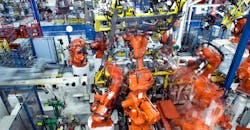Full Automation: The Path to Lights-Out Production
Sometimes referred to as lights-sparse or lights-out factories, the concept of a dark factory revolves around the development of fully automated production facilities that run 24/7 without human intervention.
A couple of standout examples: In Japan, FANUC has been running lights-out production since 2001 and today employs lights-out production with the aid of large fleets of robots. In the Netherlands, a Philips plant produces electric razors with a team of 128 robots and just nine human quality assurance workers.
And who can ignore Elon Musk’s obsession with achieving “alien dreadnought,” an in-house term for Musk’s ambitions for a hyper-automated vehicle factory. Plans to create a factory so highly automated it outshines efficiency relative to its rivals have yet to materialize, but that hasn’t stopped audacious declarations about Tesla’s production lines being more than 75% automated.
A phrase used in jest can reveal a lot about our hopes and fears. In this case, querying what the transformation of the assembly line might look like with scarcely a person in sight.
The upcoming July/August issue of Machine Design explores manufacturing automation through the lens of the dark factory. The subtext: Are we there yet?
Think of the work that goes into designing a dark factory as a proxy for a manufacturer’s automation maturity model. While automation goals differ for companies based on their level of maturity, the process is highly dependent on computing power, software and networking technologies to speed up assembly, installation, the maintenance of robots and, of course, workers’ skill sets.
It is no longer the case that sensors and actuators are constrained by being connected to robot controllers with dedicated wiring through connectors and junction boxes. Today, plug-and-play solutions are simplifying connections and networks link robots to wider production systems. Sensor technology allow robots to take on new roles. For instance, robots use force feedback to perform deburring, grinding and polishing tasks and spectral analysis for checking the quality of a weld.
Automation is helping manufacturers of all sizes carve new working relationships. For the sake of future-proofing, flexibility and sustainability between now and 2030, manufacturers are accelerating adoption. And where business confidence in integrating legacy technology is low, the preference is for partnering and standardized integration, according to a McKinsey survey of 188 industrial automation users and vendors.
Fifty-four percent of manufacturing companies now use OEM partnerships in a bid to develop standardized industrial IoT platforms—an eightfold increase since 2019, reported McKinsey. The large majority (94%) of users in the survey see digital solutions as part-and-parcel to their automation efforts in the future. Analysts expect this attitude will shape both user and manufacturer initiatives in the coming years.
I was armed with this knowledge while hosting a webinar on the topic of “Lights-Out Manufacturing: Exploring Full Automation,” which left me only mildly surprised that by coincidence my guests (representatives from FANUC and Fabco-Air, a Festo company) had a vendor/user relationship. Fabco-Air has practised lights-out processing for about 18 years, in part by shifting from using traditional rotary parts collectors to using robots to collect parts at the end of machines.
Machine Design’s technical editor, Sharon Spielman, who tackled the lights-out concept from a supply chain perspective, similarly found that the biggest leap that influences an automation implementation has to do with gaining control over hardware through digitization and using emergent tools such as artificial intelligence and machine learning. “We need some kind of connective tissue that now allows interoperability to happen between all these solutions to make a dark factory feasible,” said Guy Courtin, vice president of Industry and Advanced Technology at Tecsys Inc. (Read “Dark Factories: Science Fiction or Reality?” on p. 14.)
Building capabilities and scaling advanced manufacturing technologies should be a no-regret move. Yet, many companies are stuck in “pilot purgatory,” a state in which manufacturers have significant activity underway but their projects don’t see bottom-line benefits.
There is a cautionary note for those companies striving to move up the automation stack and aim to be software-defined: Automation for its own sake will imperil best efforts—it’s costly, takes a long time to implement and fails to deliver on business objectives.
Successful automation strategies stem instead from good decision-making, and there are definite steps users can take. For best examples to emulate, look to the World Economic Forum’s Global Lighthouse Network, a platform of 132 manufacturers. They are leading the way by applying Fourth Industrial Revolution technologies (4IR)—ranging from AI and robotics to cloud computing and big data—to increase productivity, engage workforces, lower emissions and build supply chain resilience.
As always, your feedback ensures our relevance. Email me at [email protected].
More Lights-out Manufacturing Coverage
Barely There: Replacing Manual Operations with Lights-out Processes
About the Author

Rehana Begg
Editor-in-Chief, Machine Design
As Machine Design’s content lead, Rehana Begg is tasked with elevating the voice of the design and multi-disciplinary engineer in the face of digital transformation and engineering innovation. Begg has more than 24 years of editorial experience and has spent the past decade in the trenches of industrial manufacturing, focusing on new technologies, manufacturing innovation and business. Her B2B career has taken her from corporate boardrooms to plant floors and underground mining stopes, covering everything from automation & IIoT, robotics, mechanical design and additive manufacturing to plant operations, maintenance, reliability and continuous improvement. Begg holds an MBA, a Master of Journalism degree, and a BA (Hons.) in Political Science. She is committed to lifelong learning and feeds her passion for innovation in publishing, transparent science and clear communication by attending relevant conferences and seminars/workshops.
Follow Rehana Begg via the following social media handles:
X: @rehanabegg
LinkedIn: @rehanabegg and @MachineDesign
